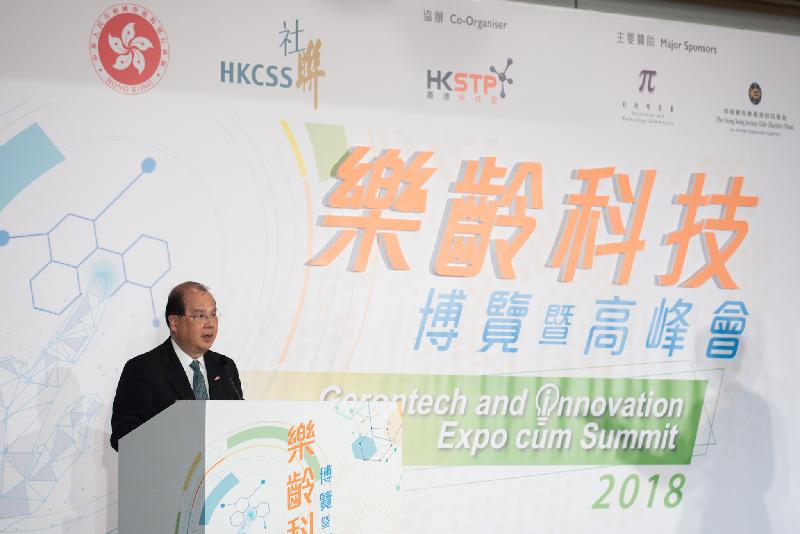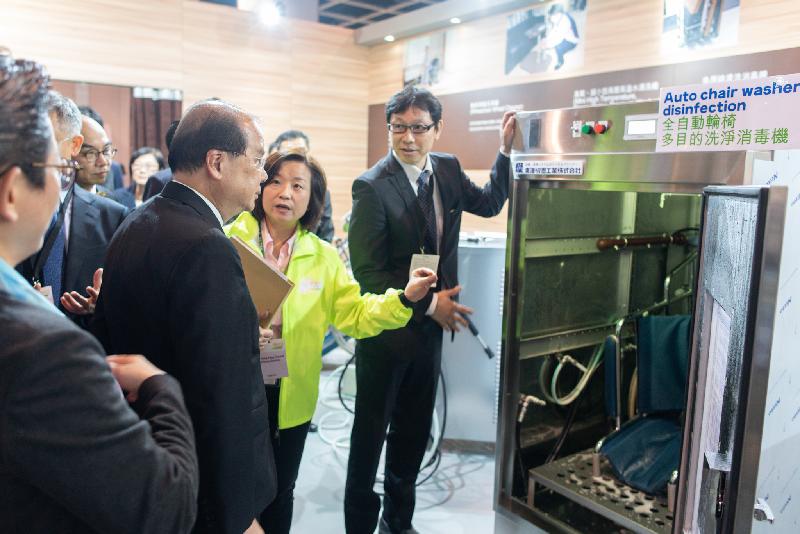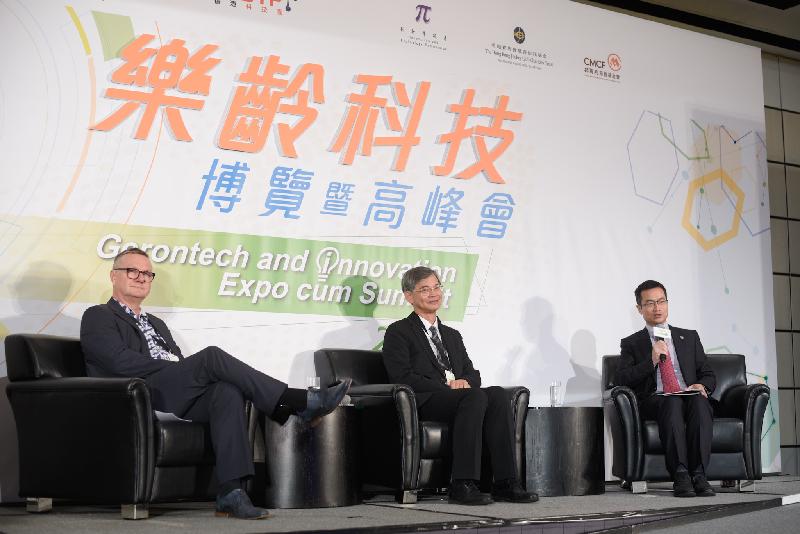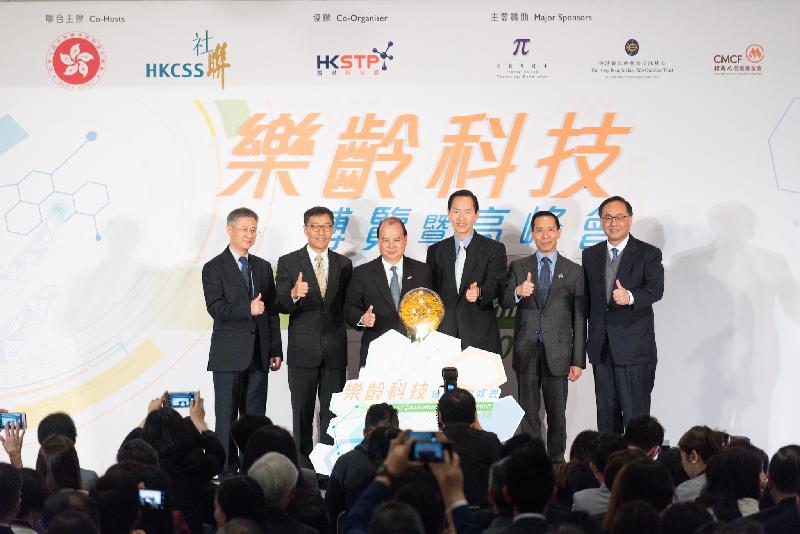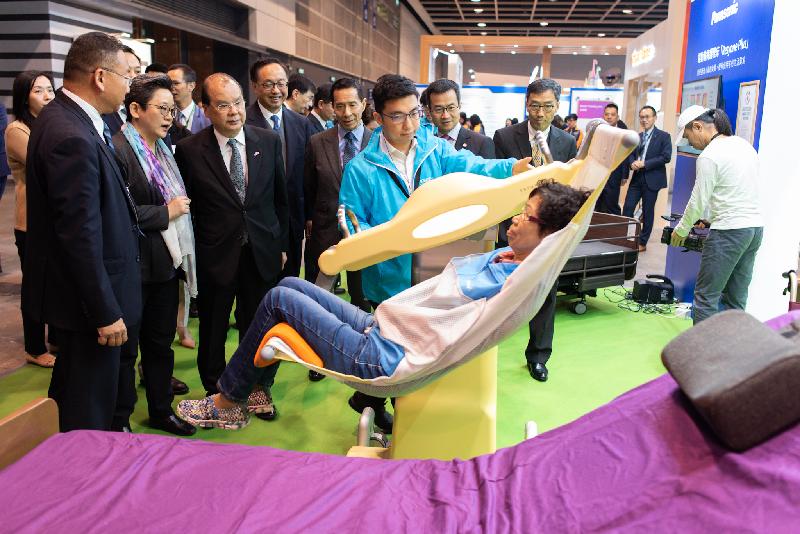Following is the speech by the Chief Secretary for Administration, Mr Matthew Cheung Kin-chung, at the opening ceremony of the Gerontech and Innovation Expo cum Summit today (November 22):
Dr Bernard Chan (Chairman of the Hong Kong Council of Social Service), Mr Albert Wong (Chief Executive Officer of Hong Kong Science and Technology Parks Corporation), Mr Richard Tang (Steward of The Hong Kong Jockey Club), Mr Chu Zongsheng (Member of the Board of Directors of the China Merchants Charitable Foundation), distinguished guests, ladies and gentlemen,
Good morning. It gives me great pleasure to join you all again at the Gerontech and Innovation Expo cum Summit (GIES). First and foremost, I would like to extend my warmest welcome to all participants, especially those from different parts of the world.
Following the successful launch of the first edition last year, which attracted over 43 000 visitors, this year’s Summit will feature a keynote session and three plenary sessions for international and local experts to share their experience and exchange views on issues related to population ageing and gerontechnology. The expo this year occupies over 8 000-square metres of exhibition floor to showcase around 380 inventions and products from some 130 local and international exhibitors.
I just had the privilege of touring around the Expo before coming here. I am truly amazed by the wide range of state-of-the-art technologies and the possibilities that they may create for our elderly citizens. Some products to be shown at the Expo will be exhibited for the first time in Hong Kong. I strongly encourage you to spare some time to visit the Expo in the next few days. As an important preamble, let me make the point that the Hong Kong Special Administrative Region (HKSAR) Government attaches great importance to the well-being of our elderly citizens. Government recurrent spending on the elderly, including social welfare services, medical services and other support services, amounts to 20 per cent, or HK$86 billion, of total government expenditure.
Thanks to our high quality and efficient healthcare services, increasing awareness of healthy diet, easy access to green space, country parks and beaches, Hong Kong has become one of the places enjoying the longest life expectancy in the world. Today, one in six people here is aged 65 or above, and this ratio will become about one in three in 20 years’ time. With a continuously increasing life expectancy and the “baby boomers” approaching old age, the number of “old-olds”, that is, those aged 85 or above, will grow at an even faster rate, constituting around 16 per cent of the elderly population in 20 years’ time and almost 30 per cent in 50 years.
Whilst Hong Kong enjoys the status of an economy with the longest life expectancy worldwide, we must not be complacent. The HKSAR Government is mindful of the challenges posed by an ageing population and is determined to adopt an innovative approach in exploring solutions, including applying innovation and technology to elderly services and rehabilitation, and considering new modes of service delivery in order to keep abreast of the changing needs of elderly persons and ensure more effective use of limited resources.
Gerontechnology, a combination of elderly services and innovation and technology, is increasingly seen as a key strategy to help fulfil the needs of an ageing population through technological intervention. Many places around the world, including Hong Kong, have begun to develop and adopt technology solutions that raise the efficiency of elderly care services whilst enabling the active and healthy living of the elderly.
The development of gerontechnology brings many benefits to the elderly and improves their quality of life, such as sensor-based alarm systems, robotic training devices, remote monitoring of health conditions as well as user-friendly communication technologies, that can support the elderly to live independently, safely and securely at home and strengthen their social connections.
Gerontechnology also provides technical support to caretakers, such as technologies for lifting and transferring persons that can relieve carers’ physical burden, thereby improving efficiency for elderly care services and alleviating manpower pressure on the elderly care sector.
Over the years, the HKSAR Government has rolled out different funding programmes under the Innovation and Technology Fund to provide subsidies to encourage universities, local public research institutions such as research and development (R&D) centres and private companies, to conduct R&D projects in various technology areas and conduct trials of their R&D outcomes in the public sector, including projects involving gerontechnology.
For example, the first round of the Midstream Research Programme for Universities held in 2017 supported eight projects under the theme “Elderly Health and Care”, with a total funding of HK$33.6 million. We are also providing additional funding for Innovation and Technology Fund-funded R&D projects and incubatees, or graduate tenants of Cyberport and the Hong Kong Science and Technology Parks Corporation, through the Public Sector Trial Scheme for the production of prototypes/samples for trials in the public sector, such as elderly service units subvented by the Social Welfare Department.
In addition, the HK$500 million Innovation and Technology Fund for Better Living was launched in May last year to finance projects that make use of innovation and technology to make people’s daily living safer, more convenient and comfortable, and address the needs of specific community groups including the elderly community.
However, driving the adoption of technologies for elderly care services is not without challenges. The adoption of gerontechnology solutions or products in Hong Kong remains limited mainly because many elderly-friendly technologies have not been widely applied in the elderly care sector. Possible difficulties include the lack of funding for product commercialisation, shortage of testing grounds, difficulties associated with localising imported products, and limited knowledge or affordability of the elderly.
To proactively promote gerontechnology for improving the quality of life of elderly persons and reduce the burden and pressure of carers and care staff, I would like to take this opportunity to announce formally that the HK$1 billion Innovation and Technology Fund for Application in Elderly and Rehabilitation Care will be launched and open for applications on December 3 this year.
The Fund will subsidise elderly and rehabilitation service units to try out and procure or rent technology products. All NGOs and private organisations currently providing government subsidised residential care services, community care and support services and day rehabilitation services for the elderly or persons with disabilities are eligible to apply for the fund. It is estimated that over 1 260 service units could benefit from this new funding programme.
The technology products that may be covered by the Fund include devices, equipment and tools that can help enhance the effectiveness and quality of care, such as electric climbers (電動爬樓梯機) and robotic care bed-cum-wheelchairs (電動輪椅è·ç�†åºŠ). The Fund will also subsidise mobile applications as well as hardware and software systems that can effectively and accurately record the activities, health and medical conditions, etc, of elderly persons and persons with disabilities. Examples include infrared bedside sensors (紅外線離床è¦å ±å™¨) and virtual reality-based rehabilitation systems (虛擬實景電腦輔助康復訓練系統). A briefing session for target service operators will be conducted later this month and more details regarding the application will be uploaded to the Social Welfare Department’s website.
Apart from applying innovation and technology solutions to promote active ageing, the HKSAR Government strives to provide quality, cost-effective and long-term care services for elderly, with a view to achieving our policy objective of promoting “ageing in place as the core, institutional care as back-up”. Services that we have introduced include both centre-based and home-based community care services for elderly persons who can continue to age in their own home and community safely, independently, and comfortably. We also provide residential care services for those who are unable to live at home owing to personal, social or health reasons.
To better suit the needs of elders, we are exploring “innovative” modes of service delivery to enhance our capacity. We have implemented two pilot schemes to test a new funding mode, namely “money-following-the-user”, to enable Government to provide subsidies directly to service users in the form of service vouchers. Through this new funding mode, the elderly can freely choose the best suitable service providers and service packages for themselves. This will, in turn, give service providers the incentive to improve service quality and be more responsive to elderly’s needs.
The Pilot Scheme on Community Care Service Voucher for the Elderly allows elderly persons living in the community to choose community care services according to their needs. To enhance home and community care services for the benefit of more elderly people, we will increase the number of Community Care Service Vouchers for the elderly in 2019/20 by an additional 1 000 to a total of 7 000. As for elderly people who require residential care, the Pilot Scheme on Residential Care Service Voucher for the Elderly aims to provide more choices for elderly persons in need of residential care service. They can choose the services provided by eligible residential care homes for the elderly operated by NGOs or the private sector according to their needs.
Most of the districts in Hong Kong are members of the WHO global network of age-friendly cities. To encourage our older generation to stay active, we have introduced the Government Public Transport Fare Concession Scheme for the Elderly and Eligible Persons with Disabilities, or the “two dollar scheme” (å…©å…ƒä¹˜è»Šå„ªæƒ ), to enable elderly people and eligible persons with disabilities to travel on designated public transport modes and services at a concessionary fare of HK$2 per trip. Average daily passenger trips under the Scheme from June 2018 to August 2018 numbered about 1 290 000, among which about 1 130 000, or 88 per cent, were made by our elderly citizens.
Ladies and gentlemen, the HKSAR Government will continue to promote gerontechnology and innovative solutions to ensure that our elderly citizens can spend their golden years actively, safely, happily and healthily. However, the Government’s efforts alone can never be enough. We need cross-sector collaboration, cross-discipline, cross-generation co-operation to realise fully our goal.
The Gerontech and Innovation Expo cum Summit is a shining example of successful cross-sector collaboration to tackle population ageing, enhance the quality of life of elderly persons and address the needs of persons with disabilities. It is co-organised by the HKSAR Government, the Hong Kong Council of Social Service and the Hong Kong Science and Technology Parks Corporation. Together they develop this valuable platform for all stakeholders, from experts, industry leaders and policy makers in relevant disciplines to elderly persons and their families and carers to share their views and ideas to enhance public awareness on technology and innovation for our elderly population.
Before I close, I must pay warm tribute to the Hong Kong Jockey Club Charities Trust, the China Merchants Charitable Foundation for their generous sponsorship to make this mega expo and summit possible. In particular, the Hong Kong Jockey Club has been instrumental over the years in promoting elderly services and elderly care. I must say that it has been a strong supporter of the Government, walking hand in hand for the benefit of our elderly population.
On this encouraging note, I wish the Gerontech and Innovation Expo cum Summit 2018 a great success and all participants a most inspiring and fruitful experience. Thank you.
read more


